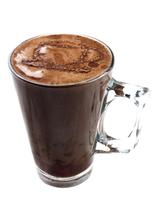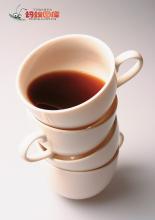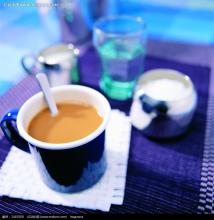Cappuccino mixed coffee introduces the requirements of coffee blending.
Cappuccino Coffee-introduction
At the beginning of the 20th century, when the Italian Azibucha invented the steam pressure coffee machine, he also developed cappuccino coffee. Cappuccino is an Italian coffee mixed with the same amount of Italian espresso and steamed milk. At this time, the color of coffee is like a cappuccino monk covering a dark brown coat with a headscarf, hence the name caffeine. The traditional cappuccino is 1/3 espresso, 1/3 steamed milk and 1/3 foamed milk.
Cappuccino coffee
Cappuccino coffee atlas
The full-bodied taste of espresso, accompanied by lubricated foam; it has a hint of essence and dew. Sprinkled with foamed milk with cinnamon powder, mixed with the aroma of bottom-up Italian coffee, the new generation of coffee is fascinated by it.
It has an irresistible unique charm, at first it smells good, the first sip, you can feel a lot of milk foam sweet and soft, the second mouthful can really taste the original bitterness and rich coffee beans, finally, when the taste stays in the mouth, you will feel more mellow and meaningful.
Don't you think it's amazing that a kind of coffee can have many different unique flavors? The first mouthful always makes people feel bitter and sour, a large number of bubbles are like young people's light life, and the bursting of bubbles and that little bitterness are like a conflict between dreams and reality. Finally, after tasting the joys and sorrows of life, the sweetness of life is intoxicating.
Cappuccino coffee-history
Cappuccino coffee
Cappuccino coffee atlas
Cappuccino coffee tastes good, but its origin is more knowledgeable, and it has always been the best material for studying text changes in Europe and the United States.
The history of the word Cappuccino is enough to show that a word is often extended to other meanings because it looks like something, far beyond the original intention of the creator. It sounds complicated. Take a look at the following analysis.
The monks of the St. Franciscan Church (Capuchin), founded after 1525, all wore brown robes and pointed hats. When the St. Franciscan Church spread to Italy, the locals thought that the monks' clothes were very special, so they gave them the name Cappuccino. The Italian word refers to the loose robes and small pointed hats worn by monks, derived from the Italian word "headscarf" or Cappuccio.
However, Lao Yi loved coffee and found that when espresso, milk and milk foam were mixed, the color was like the dark brown robe worn by monks, so he came up with a drink with coffee and sharp milk bubbles, which was named Cappuccino. The word was first used in English in 1948, when a report in San Francisco first introduced cappuccino beverages, and it was not until 1990 that it became a familiar coffee drink. It should be possible to say that the word Cappuccino coffee comes from the St. Franciscan Church (Capuchin) and the Italian headscarf (Cappucio). It is believed that the original word makers of Cappuccino never dreamed that the monks' robes would eventually become the name of a coffee drink.
Viennese Fanz George Kolschitsky, the founder of Cafe Latte with Milk and Coffee, will talk about the origin of Cappuccino in this issue. Both drinks are made from coffee and milk, but cappuccino has a more knowledgeable origin and has always been the best material for the study of character changes in Europe and the United States.
Cappuccino coffee is a change of Italian coffee, that is, strong coffee is poured with steamed milk, and the color of the coffee is like the headscarf on the dark brown coat of cappuccino monks, hence the name caffeine.

Important Notice :
前街咖啡 FrontStreet Coffee has moved to new addredd:
FrontStreet Coffee Address: 315,Donghua East Road,GuangZhou
Tel:020 38364473
- Prev

Can the same kind of coffee beans be blended with different roasting degrees?
Baking is also related to the birthplace of Espresso. Espresso is a coffee extraction method that originated in Italy. At the end of the 19th century and the beginning of the 20th century, when Espresso extraction was born, Italy was not a rich country in Europe. Due to its own economic strength, the popular coffee in Italy was not of high quality, and most of them drank inferior robusta coffee.
- Next

Introduction of Coffee blending introduction of the three benefits of blending Coffee
1. Stable flavor because coffee beans are a kind of crop, the flavor of even the same kind of coffee beans will be different from year to year, so mixing several kinds of coffee beans can solve this problem very well. can make the taste basically the same every year. two。 Balanced taste because one of the features of the Italian coffee machine is that it will bring the most prominent flavor of the coffee beans.
Related
- Does Rose Summer choose Blue, Green or Red? Detailed explanation of Rose Summer Coffee plots and Classification in Panamanian Jade Manor
- What is the difference between the origin, producing area, processing plant, cooperative and manor of coffee beans?
- How fine does the espresso powder fit? how to grind the espresso?
- Sca coffee roasting degree color card coffee roasting degree 8 roasting color values what do you mean?
- The practice of lattes: how to make lattes at home
- Introduction to Indonesian Fine Coffee beans-- Java Coffee producing area of Indonesian Arabica Coffee
- How much will the flavor of light and medium roasted rose summer be expressed? What baking level is rose summer suitable for?
- Introduction to the characteristics of washing, sun-drying or wet-planing coffee commonly used in Mantenin, Indonesia
- Price characteristics of Arabica Coffee Bean Starbucks introduction to Manning Coffee Bean Taste producing area Variety Manor
- What is the authentic Yega flavor? What are the flavor characteristics of the really excellent Yejasuffi coffee beans?

